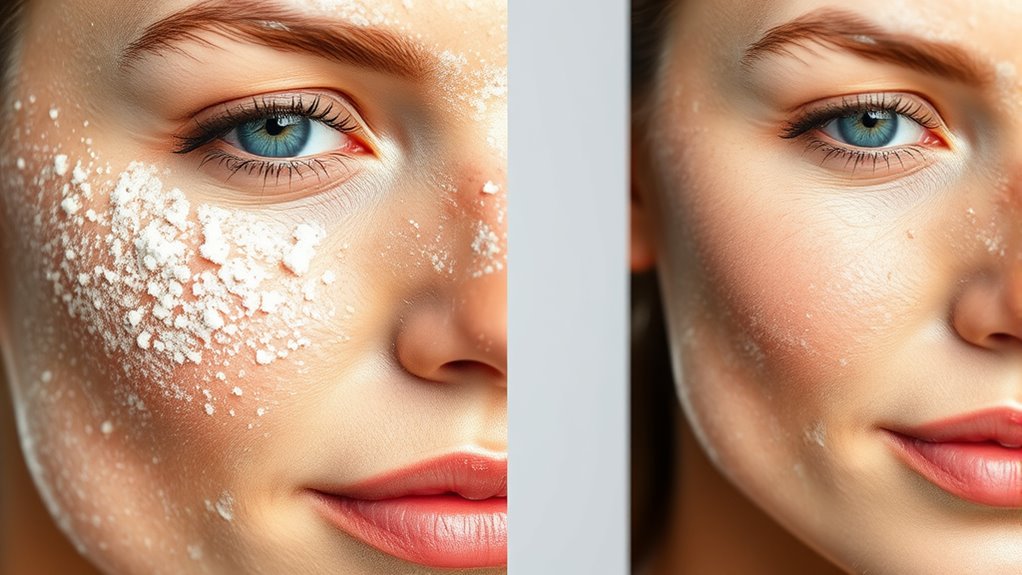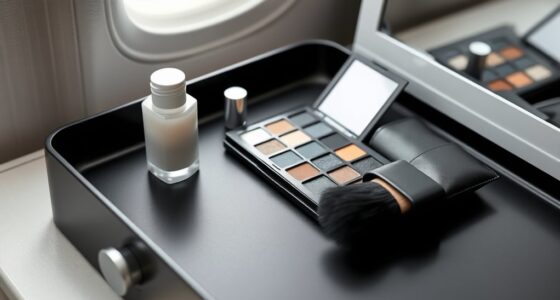Physical exfoliation involves using scrubs or brushes to manually slough off dead skin cells through friction, providing immediate results but risking irritation if overdone. Chemical exfoliation uses enzymes or acids to dissolve dead skin without physical scrubbing, offering a gentler option that promotes cell turnover over time. Each method suits different skin types and needs—keep exploring to find which works best for your skincare routine.
Key Takeaways
- Physical exfoliation uses manual scrubs or brushes to physically remove dead skin, providing immediate results.
- Chemical exfoliation involves enzymes or acids that dissolve dead skin cells without physical abrasion.
- Physical methods may cause irritation or microtears if overused or applied with excessive pressure.
- Chemical exfoliants are gentler for sensitive skin but require proper application and timing.
- Both methods can be effective; choosing depends on skin type, sensitivity, and personal preference.

When it comes to achieving smooth, glowing skin, exfoliation is a key step, but choosing the right method can be confusing. You might wonder whether to go for physical or chemical exfoliation, or how to decide between different types within those categories. One of the first considerations is understanding the difference between natural vs synthetic products. Natural exfoliants often contain ingredients like sugar, salt, coffee grounds, or crushed seeds. These are typically perceived as gentler and more eco-friendly, appealing to those who prefer organic options. Synthetic exfoliants, on the other hand, include manufactured microbeads or chemically engineered particles. While some synthetic options are highly effective and uniform in size, they can raise concerns about environmental impact and skin sensitivity.
Within physical exfoliation, you’ll find manual methods like scrubs and brushes. Manual exfoliation involves physically removing dead skin cells through friction. It’s straightforward—you apply the scrub and gently massage your skin, then rinse. This method offers immediate results and a tactile experience, making it popular for those who want quick, visible improvements. However, if not used carefully, it can cause irritation or microtears, especially on sensitive skin. Enzymatic exfoliation, a type of chemical exfoliation, uses enzymes derived from fruits like papaya or pineapple. These enzymes break down dead skin cells without abrasive scrubbing, making them a gentler alternative. Enzymatic options are especially suitable if you prefer a natural approach but want the benefits of chemical exfoliation. They work by dissolving the bonds holding dead cells together, promoting cell turnover without the risk of physical damage. Additionally, choosing a HEPA filter air purifier can help reduce airborne irritants that might exacerbate skin sensitivities.
Deciding between manual and enzymatic exfoliation depends on your skin type and preferences. If your skin is resilient and you enjoy a tactile experience, manual scrubs might suit you. But if you have sensitive or easily irritated skin, enzymatic exfoliants could be a better choice. They provide effective exfoliation without harsh scrubbing, reducing the risk of irritation. Both methods can be incorporated into your skincare routine, but it’s important to use them properly. For manual scrubs, avoid excessive pressure and don’t overdo it—once or twice a week is sufficient. For enzymatic exfoliants, follow the instructions carefully, as overuse can lead to dryness or sensitivity. Ultimately, understanding your skin’s needs and preferences will help you pick the right exfoliation method, ensuring you achieve that smooth, radiant complexion safely and effectively.
Frequently Asked Questions
Can Physical Exfoliation Cause Skin Microtears?
Yes, physical exfoliation can cause skin microtears if you’re too rough or use abrasive scrubs. These microtears damage your skin barrier, leading to irritation and increased sensitivity. To prevent exfoliation damage, choose gentle scrub textures and avoid applying excessive pressure. Properly performed, physical exfoliation can improve skin texture, but overdoing it risks microtears that compromise your skin’s health and barrier function.
Are Chemical Exfoliants Safe for Sensitive Skin Types?
Chemical exfoliants can be safe for sensitive skin if you choose gentle formulations with a balanced pH. Look for products labeled for sensitive skin, and start with a lower concentration. Always patch-test first, and avoid over-exfoliating to prevent irritation. Maintaining the right pH helps keep your skin’s barrier intact, making chemical exfoliants effective yet gentle enough for sensitive skin types.
How Often Should I Exfoliate With Each Method?
Exfoliating too often can turn your skin into a fiery battlefield! For physical exfoliants, use them 1-3 times a week, depending on your skin’s tolerance, ensuring product compatibility. Chemical exfoliants are gentler; you can use them 2-3 times weekly, but always check your product’s recommended exfoliation frequency. Overdoing it can cause irritation, so listen to your skin and adjust accordingly for a radiant, balanced glow.
What Are the Long-Term Effects of Chemical Exfoliation?
Chemical exfoliation, when done properly, can improve your skin over time by boosting cell turnover and brightening your complexion. However, if you overuse it, you might weaken your skin barrier, leading to increased sensitivity and ingredient buildup. Long-term, it’s essential to balance exfoliation with moisturizing and avoid harsh acids to keep your skin healthy, resilient, and free from irritation or damage.
Can Combining Both Exfoliation Methods Improve Skin Results?
Imagine revealing the secret to radiant skin through exfoliation synergy—you absolutely can combine both methods. This dual action benefits your skin by maximizing cell turnover and deep cleaning. When done carefully, it creates a powerful glow, like a symphony of renewal. Just be mindful not to overdo it; skin needs balance. This balanced approach amplifies results, giving you a refreshed, smoother complexion with the perfect exfoliation harmony.
Conclusion
Whether you choose physical or chemical exfoliation, remember that both can give your skin a radiant glow. If you’re worried about irritation, start with gentle options and patch test first—it’s better to be cautious than risk damage. Think of exfoliation as a way to refresh your skin’s natural beauty, not a harsh treatment. With the right approach, you’ll enjoy smoother, brighter skin without discomfort or worry.









